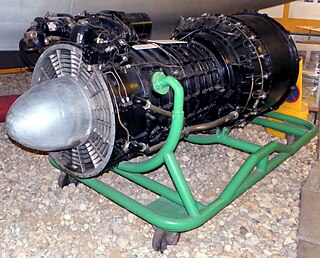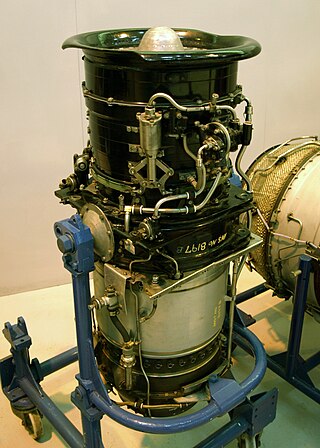
The Junkers Jumo 004 was the world's first production turbojet engine in operational use, and the first successful axial compressor turbojet engine. Some 8,000 units were manufactured by Junkers in Germany late in World War II, powering the Messerschmitt Me 262 fighter and the Arado Ar 234 reconnaissance/bomber, along with prototypes, including the Horten Ho 229. Variants and copies of the engine were produced in Eastern Europe and the USSR for several years following the end of WWII.

The BMW 003 is an early axial turbojet engine produced by BMW AG in Germany during World War II. The 003 and the Junkers Jumo 004 were the only German turbojet engines to reach production during World War II.

The General Electric/Allison J35 was the United States Air Force's first axial-flow compressor jet engine. Originally developed by General Electric in parallel with the Whittle-based centrifugal-flow J33, the J35 was a fairly simple turbojet, consisting of an eleven-stage axial-flow compressor and a single-stage turbine. With the afterburner, which most models carried, it produced a thrust of 7,400 lbf (33 kN).
This article outlines the important developments in the history of the development of the air-breathing (duct) jet engine. Although the most common type, the gas turbine powered jet engine, was certainly a 20th-century invention, many of the needed advances in theory and technology leading to this invention were made well before this time.

The Metropolitan-Vickers F.2 is an early turbojet engine and the first British design to be based on an axial-flow compressor. It was an extremely advanced design for the era, using a nine-stage axial compressor, annular combustor, and a two-stage turbine.

The Armstrong Siddeley Sapphire is a British turbojet engine that was produced by Armstrong Siddeley in the 1950s. It was the ultimate development of work that had started as the Metrovick F.2 in 1940, evolving into an advanced axial flow design with an annular combustion chamber that developed over 11,000 lbf (49 kN). It powered early versions of the Hawker Hunter and Handley Page Victor, and every Gloster Javelin. Production was also started under licence in the United States by Wright Aeronautical as the J65, powering a number of US designs. The Sapphire's primary competitor was the Rolls-Royce Avon.

The General Electric J47 turbojet was developed by General Electric from its earlier J35. It first flew in May 1948. The J47 was the first axial-flow turbojet approved for commercial use in the United States. It was used in many types of aircraft, and more than 30,000 were manufactured before production ceased in 1956. It saw continued service in the US military until 1978. Packard built 3,025 of the engines under license.

The General Electric J85 is a small single-shaft turbojet engine. Military versions produce up to 2,950 lbf (13.1 kN) of thrust dry; afterburning variants can reach up to 5,000 lbf (22 kN). The engine, depending upon additional equipment and specific model, weighs from 300 to 500 pounds. It is one of GE's most successful and longest in service military jet engines, with the civilian versions having logged over 16.5 million hours of operation. The United States Air Force plans to continue using the J85 in aircraft through 2040. Civilian models, known as the CJ610, are similar but supplied without an afterburner and are identical to non-afterburning J85 variants, while the CF700 adds a rear-mounted fan for improved fuel economy.

The Wright J65 was an axial-flow turbojet engine produced by Curtiss-Wright under license from Armstrong Siddeley. A development of the Sapphire, the J65 powered a number of US designs.

The Heinkel HeS 011 or Heinkel-Hirth 109-011(HeS - Heinkel Strahltriebwerke) was an advanced World War II jet engine built by Heinkel-Hirth. It featured a unique compressor arrangement, starting with a low-compression impeller in the intake, followed by a "diagonal" stage similar to a centrifugal compressor, and then a three-stage axial compressor. Many of the German jet-powered aircraft designs at the end of the war were designed to use the HeS 011, but the HeS 011 engine was not ready for production before the war ended in Europe and only small numbers of prototypes were produced.

The Armstrong Siddeley Python was an early British turboprop engine designed and built by the Armstrong Siddeley company in the mid-1940s. Its main use was in the Westland Wyvern, a carrier-based heavy fighter. The prototypes had used the Rolls-Royce Eagle piston engine, but Pythons were used in production aircraft. In this application, the Python was rated at 4,110 equivalent shaft horsepower (eshp).

The Armstrong Siddeley ASA.1 Adder was an early British turbojet engine developed by the Armstrong Siddeley company and first run in November 1948.

The Rolls-Royce RB.108 was a British jet engine designed in the mid-1950s by Rolls-Royce specifically for use as a VTOL lift engine. It was also used to provide horizontal thrust in the Short SC.1.
The Avro Canada TR.4 Chinook was Canada's first turbojet engine, designed by Turbo Research and manufactured by A.V. Roe Canada Ltd. Named for the warm Chinook wind that blows in the Rocky Mountains, only three Chinooks were built and none were used operationally. The Chinook was nevertheless an extremely successful design in terms of introducing new concepts and materials, and after being scaled up from 2,600 lbf (12 kN) to 6,500 lbf (29 kN), would become the Orenda.

The Avro Canada TR5 Orenda was the first production jet engine from Avro Canada's Gas Turbine Division. Similar to other early jet engines in design, like the Rolls-Royce Avon or General Electric J47, the Orenda nevertheless outperformed its rivals in most ways, and the Orenda-powered Canadair Sabres were among the fastest of all first-generation jet fighters. Over 4,000 Orendas of various marks were delivered during the 1950s, Avro's greatest engine success.
Between 1936 and 1940 Alan Arnold Griffith designed a series of turbine engines that were built under the direction of Hayne Constant at the Royal Aircraft Establishment (RAE). The designs were advanced for the era, typically featuring a "two-spool" layout with high- and low-pressure compressors that individually had more stages than typical engines of the era. Although advanced, the engines were also difficult to build, and only the much simpler "Freda" design would ever see production, as the Metrovick F.2 and later the Armstrong Siddeley Sapphire. Much of the pioneering work would be later used in Rolls-Royce designs, starting with the hugely successful Rolls-Royce Avon.

The General Electric J73 turbojet was developed by General Electric from the earlier J47 engine. Its original USAF designation was J47-21, but with innovative features including variable inlet guide vanes, double-shell combustor case, and 50% greater airflow was redesignated J73. Its only operational use was in the North American F-86H.

The PZL Rzeszów SO-1 and PZL Rzeszów SO-3 are Polish turbojet engines designed by the Instytut Lotnictwa and manufactured by WSK PZL Rzeszów, to power the PZL TS-11 Iskra jet trainer. Thirty SO-1s were built, this being superseded by the improved SO-3, of which a further 580 were built. The engine has a seven-stage compressor, annular combustion chambers, and a single-stage turbine.

The Turbomeca Gabizo was a small turbojet engine produced by Turbomeca from the 1950s. The components were designed to take the stresses of high-speed fighter aircraft with some variants featuring afterburner.
The Daimler-Benz DB 007 was an early German jet engine design stemming from design work carried out by Karl Leist from 1939. This was a complex design featuring contra-rotating stages and a bypass fan, making it one of the earliest turbofan designs to be produced. The end result of the design work was built as the DB 007 and began testing on a test-bed on 27 May 1943. Due to the expected low performance, complexity and the good results achieved by much simpler designs, work was halted on the DB 007 in May 1944 by order of the RLM.
















